How to Access Linux EXT4 Partition and Data on Windows 11/10/8/7 in 2022
To access an EXT4 partition from Windows 11/10/8/7, you can use one of six practical methods, which can be divided into two parts. By following these methods, you'll be able to easily access and read Linux EXT4 partition data on your Windows system.
If you are dual-If you're dual-booting Windows and Linux on your laptop or desktop, you may eventually want to access files on your Linux partition, such as EXT4, from Windows. To do this easily, you can use the Explore feature in Qiling partition manager, which allows you to make your drive data visible immediately, enabling you to access and open EXT4 partition files on your Windows PC with minimal hassle.
Part 1. Can I Read EXT4 on Windows
To read and access an EXT4 partition from Windows 10, you'll need to install a third-party driver or software that supports EXT4 file system. One popular option is Ext2Fsd, which allows you to read and write EXT4 partitions on Windows. You can download and install Ext2Fsd, then mount the EXT4 partition as a drive letter in Windows. This will enable you to access and read the files on the EXT4 partition from Windows 10. Alternatively, you can also use other software like DiskInternals Linux Reader or EaseUS Todo PCTo access and read EXT4 partitions on Windows.
If you're experiencing issues accessing or mounting a Linux EXT4 partition on Windows 10/8/7, you can try the following steps to resolve the problem. First, you need to download and install the EXT2/EXT3/EXT4 Filesystem Driver for Windows, which is available from the official Linux website. Once installed, you should be able to access and mount your EXT4 partition on Windows.
1. What is EXT4?
EXT4, the successor to EXT3, is a widely used file system for Linux users. It is the default file system for many Linux distributions, including Debian and Ubuntu, making it a popular choice among Linux users.
2. Can Windows 10 or Windows 8/7 read EXT4?
Although EXT4 is the most common Linux file system, it's not supported on Windows by default, meaning Windows cannot read EXT4 partitions. In contrast, Windows can easily access and read NTFS partitions from Linux, but the reverse is not possible.
To access EXT4 from Windows, you'll need third-party tools and resolutions to help, as Windows doesn't natively support EXT4.
To access and read Linux EXT4 partition data on Windows, you can follow the provided methods in Part 2 and Part 3, which will guide you through the process of accessing and reading the data from the Linux EXT4 partition.
Part 2. How to access Ext4 from Windows 11/10/8/7
To make a Linux hard drive accessible on Windows, first, check for important data using an EXT4 viewer tool, then format the drive to NTFS, and finally, install the EXT2/EXT3/EXT4 drivers on Windows to make the EXT4 partition accessible.
If you have saved important data, you can use a reliable EXT4 reader to access and restore the data from the partition, then format and convert the EXT4 partition to NTFS using a professional formatter, without losing any data.
To make EXT4 accessible on Windows 10/8/7, go through the following complete process: 1. Download and install the Ext2Fsd driver, 2.
If you don't care about the data, you can skip this and jump to the EXT4 formatter in #2 for help.
#1. View and Explore EXT4 Partition Content
Applies to: View EXT4 partition content and data on Windows
Important Tool: Linux EXT4 partition manager software - Qiling Partition Master
Before converting or accessing an EXT4 partition from Windows, it's crucial to check the saved content in the volume. To do this, we recommend using Qiling Partition Master, a reliable EXT4 partition manager software.
Step 1. Launch Qiling Partition Master, locate the EXT4 partition.
Step 2. Right-click on the EXT4 partition and select "Properties".
Step 3. Open and expand the folders on the left pane to check the content of EXT4 partition.
If the Linux EXT4 partition contains valuable files, you can access and regain data from it on Windows by using a third-party tool like EaseUS Partition Manager or a Linux bootable USB drive. This will allow you to mount the EXT4 partition on Windows and transfer the files to a safe location.
#2. Access EXT4 Partition Data from Windows 10/8/7
Applies to: To make an EXT4 partition accessible on Windows, you can format it to NTFS, which is a Windows-compatible file system. This will allow you to read and access the data on the EXT partition from within Windows.
Important Tools: 1. EXT4 reader; 2. EXT4 formatter tool.
To avoid data loss, access the saved data on an EXT4 partition using a reliable reader before converting it, and then make the partition accessible without losing any data.
First. Use EXT4 Reader to Read and Restore EXT4 Partition Data
To regain data from an inaccessible EXT4 partition on Windows, use a reliable EXT4 reader, such as Deep Data Recovery, a professional hard drive data recovery software.
If you lost or deleted data on other types of storage devices, such as EXT2/EXT3 partitions, FAT32 USB drives, or exFAT external hard drives, this software can quickly scan and restore everything you lost immediately.
Here, you can apply this software to scan, preview and restore everything saved in the EXT4 partition in just three simple steps.
Step 1. Launch Deep Data Recovery software on your computer, select the desired file types, and click "Next" to initiate the recovery process.

Step 2. To recover lost files, first select the drive where the files were lost. Then, click "Scan" to initiate the recovery process. If the lost files were on an external storage device, ensure it is connected to the computer before proceeding.

Step 3. The software rapidly scans deleted files, followed by a deep scan to locate more lost files. Upon completion, a "Filter" feature allows users to quickly filter specific file types.

Step 4. To recover files, click the "Preview" button or double-click on a file for a full preview. Select the desired files, click "Recover", and choose another safe location to save all the files at once.
Save the restored EXT4 partition data to another secure location on your Windows hard drive.
Next. Use EXT4 Formatter to Make EXT4 Partition Accessible on Windows
Windows doesn't support accessing Linux-based file system partitions, making it impossible for Windows users to view or modify EXT4/3/2 partitions on their PC.
To make an EXT4/3/2 partition accessible on Windows, you can try changing the file system of the Linux partition from EXT4/3/2 to a Windows-supported one like NTFS or FAT32. A reliable EXT4 formatter like Qiling Partition Master can help you achieve this.
To convert an EXT4 partition to NTFS, you can format the partition with the NTFS file system using the "format" command in the terminal, followed by the drive letter or device name, and the "/t" option to specify the file system type. For example, if you want to format the partition /dev/sda1 to NTFS, you can use the command "format /dev/sda1 /t ntfs".
Step 1. Launch Qiling Partition Master, right-click the partition you intend to format and choose "Format".
Step 2. In the new window, enter the partition label, select the file system (FAT32/EXT2/EXT3/EXT4), and set the cluster size according to your needs, then click "Proceed".
Step 3. To start the formatting process, you will see a warning window. Click "OK" to proceed.
You May Also Like:
How to Partition Hard Drive in Windows 10
After formatting the EXT4 partition to a normal file system, you may also want to repartition the volume. You can do this by partitioning the hard drive yourself, which involves dividing the drive into smaller sections to organize and manage your files more efficiently. This process can be done manually or with the help of a partitioning tool, allowing you to customize the layout of your drive to suit your specific needs.
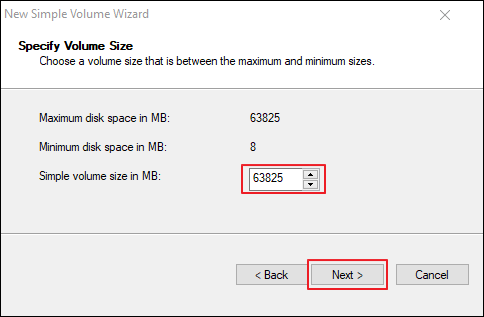
Part 3. How to Mount EXT4 on Windows 11/10/8/7
You can learn how to mount an EXT4 partition on Windows and access EXT4 files from Windows using third-party software in this section. This will allow you to work with EXT4 partitions on a Windows system.
You can mount a Linux drive in Windows 10 by using a third-party tool, such as EXT2IFS or DiskInternals Linux Reader, which allow you to access EXT4 files from Windows. Alternatively, you can use the Windows Subsystem for Linux (WSL) to run a Linux environment within Windows, which allows you to access Linux files from within Windows. Additionally, you can also use the "ext2fsd" tool to mount EXT4 partitions on Windows.
3 reliable Linux readers to mount EXT4 on Windows 10/8/7
To mount EXT4 on your Windows computer, you can use a tool such as EXT2IFS or EXT2IFS, which can be downloaded from the official website. Once installed, follow the tutorials provided with the tool to configure and mount the EXT4 file system.
#1. Mount EXT4 on Windows using Ext2Fsd
Ext2Fsd is a Windows file system driver that allows users to read and access Linux file systems like EXT4 by mounting the EXT4 partition on Windows.
After installing the EXT4 driver, you can access your EXT4 partitions in Windows Explorer, where you can find them with their own drive letters. This allows you to directly access files on the EXT4 partition. DiskInternals Linux Reader supports EXT4, ReFS, HFS and HFS+ file systems, allowing Windows users to browse and visit Linux partitions within the application, unlike Ext2Fsd. Step 1. Install and launch DiskInternals Linux Reader on Windows PC. Step 2. Locate the EXT4 partition on this application.
Step 3. Double-click to open EXT4 partition, view, and check the saved data on the partition.
Step 4. To access files on an EXT4 partition, save the selected files to a secure location on your Windows PC by clicking the "Save" button. Ext2explore is an open-A source application is needed that allows users to access the content of an EXT4 partition, similar to how DiskInternals Linux Reader works, but with the limitation that this access is only possible within this specific application. To access EXT4 from Windows via Ext2explore, download and install the Ext2explore software, which allows you to browse and access EXT4 partitions from Windows. Once installed, you can launch the software and it will automatically detect the EXT4 partitions on your system. Step 1. Download Ext2explore.ext and run this program on Windows PC. Step 2. Once launched, right-click on it and select to "Run as administrator". You can also right-To run the Ext2explore.exe program, click on it and select "Properties" in the context menu. In the Properties window, navigate to the Compatibility tab, check the box that says "Run this program as an administrator", and then click "OK" to save the changes.
Step 3. After this, you can then browse the Linux EXT4 partition and its content. To use the files, right-click on them and select "Save" to save them to a secure location on your Windows computer.
On this page, you've learned what EXT4 is and two different ways to access and open EXT4 partitions on Windows, covering the basics of the file system and providing practical solutions for users. To use a Linux EXT4 partition as a data drive on Windows, you'll need to export and restore the data using Deep Data Recovery, then convert the partition to a Windows-recognized file system like NTFS or FAT32 using Qiling Partition Master. To access EXT4 files from Windows, you'll need to mount the Linux partition on Windows, and for the most direct way, try Ext2Fsd. If you have further questions about EXT4 or Linux file systems, check the FAQs below, you may get the desired answer. 1. Can Windows read ext4? Windows Operating Systems do not natively support the Linux file system, including EXT4, which means they cannot directly read or detect an EXT4 partition or device. However, if you want to access EXT4 from Windows, there are methods available that can make it possible. 2. Which is better NTFS or EXT4? To compare the performance of NTFS and EXT4 file systems, you would need to test them in their native operating systems, as they are designed for different systems. NTFS is faster in Windows, but EXT4 is faster in Linux. 3. Can Windows write to EXT4? If you're running both Windows and Linux on the same PC, you won't be able to access EXT4 partitions from Windows, making it impossible to perform any actions on them. Windows cannot write to EXT4. To write to EXT4 on Windows, convert EXT4 to NTFS or FAT32 first using Qiling Partition Master. 4. How do I open a Linux drive in Windows? To open a Linux drive in Windows, you can either change its file system to NTFS/FAT32 or mount the Linux drive to Windows, similar to the methods shown on this page. If you want to make a Linux drive file system readable and writable, you can format it into NTFS or FAT32, and find the solutions in Part 2 on this page. If you only want to visit or access files saved on the Linux drive from Windows, you can mount the Linux drive on Windows using the recommended applications from Part 3.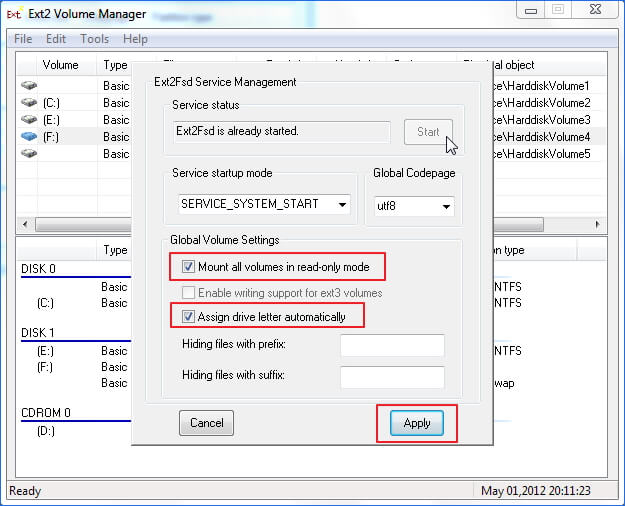
#2. Mount EXT4 Partition on Windows 10 via DiskInternals Linux Reader
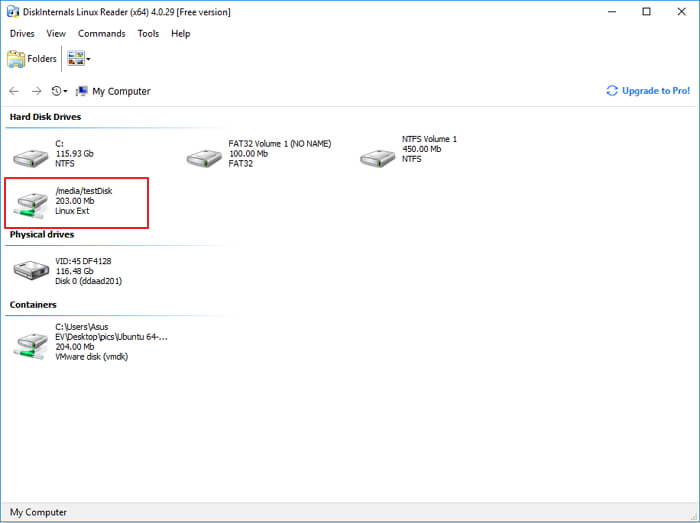
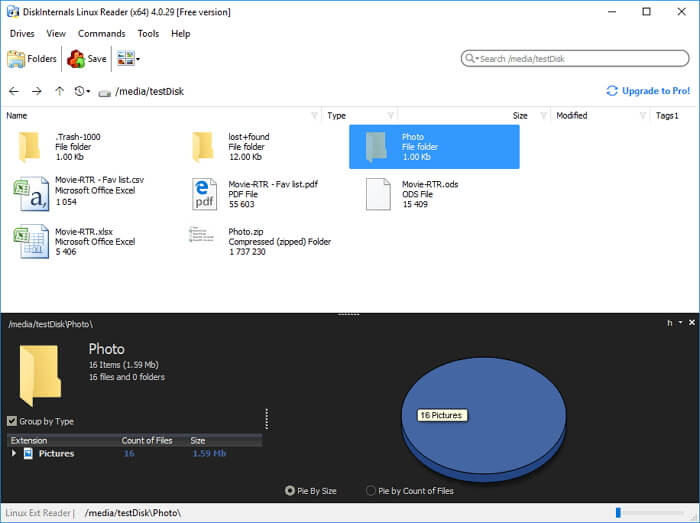
#3. Mount EXT4 on Windows using Ext2explore
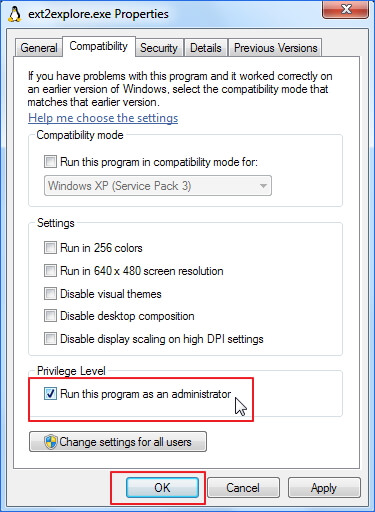
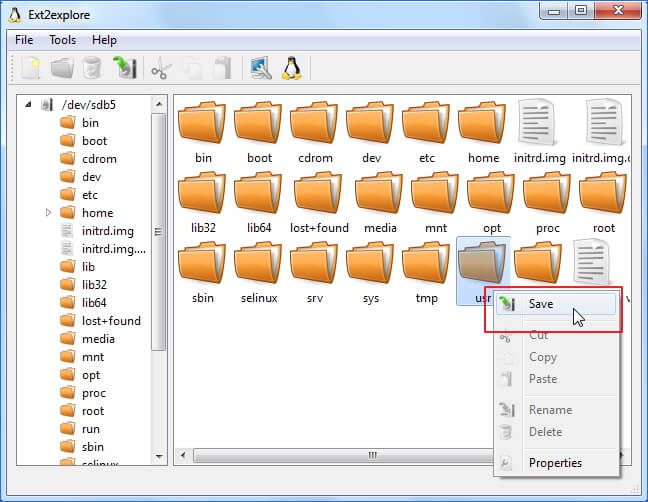
Part 4. Conclusion
FAQs about EXT4
Related Articles